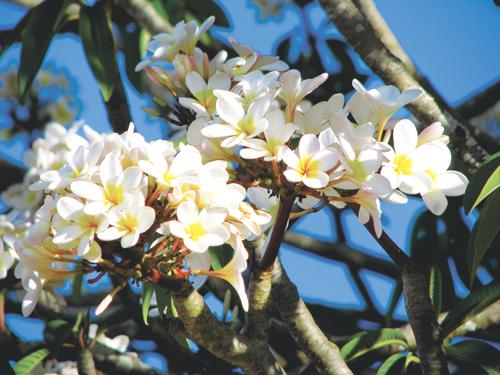Phuket Gardening – Turning over a new leaf

PHUKET: Any New Year’s resolutions about gardening? Plenty. Everywhere in the garden I see Nature’s perfection and my imperfections.
Mistakes a-plenty. Why, is there a gap in that flower bed? Ah! Because the multicolored acalypha I once put there succumbed to mildew and was never replaced. Why is the grass so threadbare near the fish pond? Because the area is now in deep shade, something Malaysia grass abhors. Don’t stand and look. Go and get a local variety.
Gardening is not an exact science, and it requires lots of attention. No garden is ever complete, nor should it be. That’s part of its charm.
Which brings me – like the ill-starred acalypha – to foliage plants. Most of us, brought up in cooler climes, formerly regarded foliage plants as essentially decorative adjuncts to the garden. Shrubs such as laurel and its relative the bay, small trees such as holly or cypress (cupressus), even neat hedges of box or privet, these were part of the average garden furniture because they provided evergreen vistas not merely in summer, but more importantly in a winter world largely stripped of color and foliage.
Leaves are inherently attractive, the more so because they come in a range of shapes, sizes, textures and hues. Their aesthetic appeal lies largely in this variety, a variety multiplied in the tropics where there is every conceivable kind of leaf available to the discerning horticulturist. And evergreen shrubs and trees are not the exception, but the rule.
In terms of sheer opulence, consider the alocasia. A tropical monster, the elephant ear is aptly named, a collection of huge ribbed, fan-shaped leaves that sprout from succulent, forearm-sized stems. They look very ‘jungley’ and exotic, with their vivid green leaves reach up to five feet across. However, they will not flourish in the average garden unless there is a ready supply of moisture and shade. Essentially, they are denizens of the forest understorey.
Almost as massive are the leaves of the fan palm (licuala), a low-slung plant, which again has no trunk to speak of, but possesses huge, undivided leaves, neatly crimped like a lady’s skirt. In the right conditions – and Rang Hill has a fine collection – the dark green fronds can be four feet across.
Palms indeed, are probably the most popular tree to be cultivated for their attractive fronds. Typically tall and statuesque, often with beautiful smooth boles, palms form a dramatic silhouette when set against a tropic sky. But unless you choose a low-growing variety such as the fan palm or the clumpy golden palm (dypsis), you will get little in the way of shade. Maybe some protection from salt-laden winds, but not much from the sun.
And that is the other main reason for growing foliage plants in the tropics. Not merely attractive in their own right, they will give other more vulnerable brethren much needed shelter from the blistering noonday sun.
This utilitarian function becomes much more important than in temperate climates. Indeed, if you are planning a garden for a new property in Phuket, where the surrounding land has probably been stripped by earth-moving equipment, the first requirement may well be to plant mature trees such as plumerias that will provide some shade for the grass and for the shrubs that will come later.
The acalypha may well be one of the first to arrive. It is not a big shrub – maybe a meter or so in height, but it will tolerate direct sun, and its leaves are so colorful – in marbled shades of bronze, yellow, green, orange and red – that it deserves its common name of Jacob’s coat. Moreover, the leaves are plentiful and add year-round color to any garden.
A good starter, but mind the mildew.
Tip of the week – Garden pests: Ants in your plants
The biggest nuisance in the garden? For me, it’s ants. They are the commonest insect – in fact they have colonized the planet. They live everywhere, under your lawn, inside your flower pots, even in trees.
They are a nuisance to us because soldier ants sting if provoked. Their stings contain formic acid, and can become painful and inflamed if you are allergic to the toxin. If red ants make a nest in one of your broad-leaved shrubs (look for tell-tale discolored leaves), cut off the affected branch and stamp the nest underfoot.
Ants are a nuisance to plants because they are partial to honeydew excreted by sap-sucking insects such as aphids and mealybugs, and stop other predators such as ladybirds from attacking them. The affected plant may then fall victim to a secondary infestation of mold or fungus.
If you have a question or a garden that you would like featured, you can email the author here.
Keep checking our online Phuket Lifestyle pages or join our Facebook fan page for regular gardening features and tips.
— Patrick Campbell
Latest Thailand News
Follow The Thaiger on Google News:


























